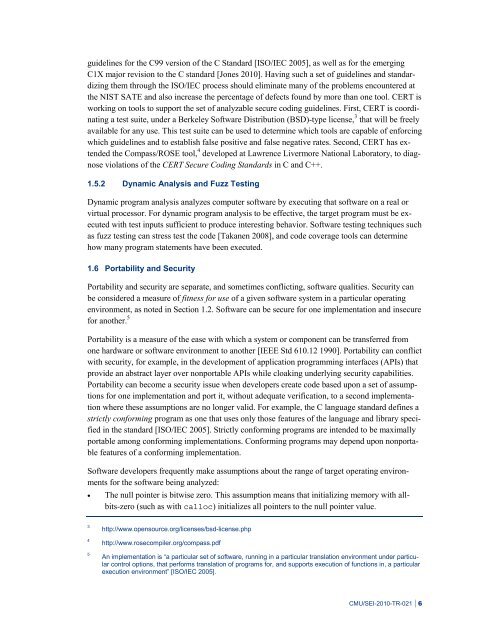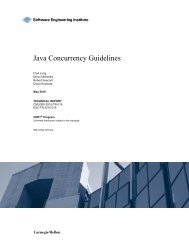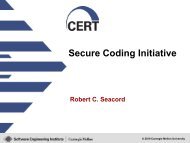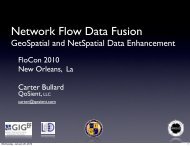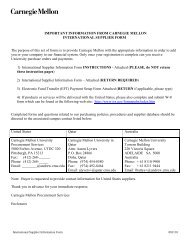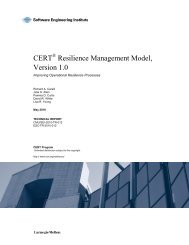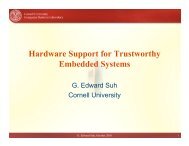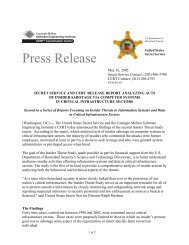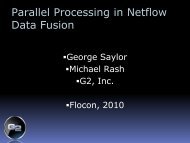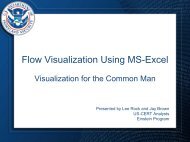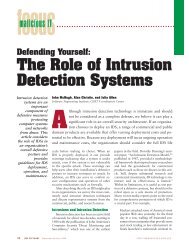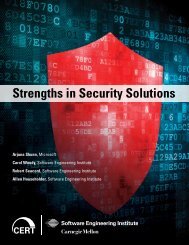Source Code Analysis Laboratory (SCALe) for Energy ... - CERT
Source Code Analysis Laboratory (SCALe) for Energy ... - CERT
Source Code Analysis Laboratory (SCALe) for Energy ... - CERT
Create successful ePaper yourself
Turn your PDF publications into a flip-book with our unique Google optimized e-Paper software.
guidelines <strong>for</strong> the C99 version of the C Standard [ISO/IEC 2005], as well as <strong>for</strong> the emerging<br />
C1X major revision to the C standard [Jones 2010]. Having such a set of guidelines and standardizing<br />
them through the ISO/IEC process should eliminate many of the problems encountered at<br />
the NIST SATE and also increase the percentage of defects found by more than one tool. <strong>CERT</strong> is<br />
working on tools to support the set of analyzable secure coding guidelines. First, <strong>CERT</strong> is coordinating<br />
a test suite, under a Berkeley Software Distribution (BSD)-type license, 3 that will be freely<br />
available <strong>for</strong> any use. This test suite can be used to determine which tools are capable of en<strong>for</strong>cing<br />
which guidelines and to establish false positive and false negative rates. Second, <strong>CERT</strong> has extended<br />
the Compass/ROSE tool, 4 developed at Lawrence Livermore National <strong>Laboratory</strong>, to diagnose<br />
violations of the <strong>CERT</strong> Secure Coding Standards in C and C++.<br />
1.5.2 Dynamic <strong>Analysis</strong> and Fuzz Testing<br />
Dynamic program analysis analyzes computer software by executing that software on a real or<br />
virtual processor. For dynamic program analysis to be effective, the target program must be executed<br />
with test inputs sufficient to produce interesting behavior. Software testing techniques such<br />
as fuzz testing can stress test the code [Takanen 2008], and code coverage tools can determine<br />
how many program statements have been executed.<br />
1.6 Portability and Security<br />
Portability and security are separate, and sometimes conflicting, software qualities. Security can<br />
be considered a measure of fitness <strong>for</strong> use of a given software system in a particular operating<br />
environment, as noted in Section 1.2. Software can be secure <strong>for</strong> one implementation and insecure<br />
<strong>for</strong> another. 5<br />
Portability is a measure of the ease with which a system or component can be transferred from<br />
one hardware or software environment to another [IEEE Std 610.12 1990]. Portability can conflict<br />
with security, <strong>for</strong> example, in the development of application programming interfaces (APIs) that<br />
provide an abstract layer over nonportable APIs while cloaking underlying security capabilities.<br />
Portability can become a security issue when developers create code based upon a set of assumptions<br />
<strong>for</strong> one implementation and port it, without adequate verification, to a second implementation<br />
where these assumptions are no longer valid. For example, the C language standard defines a<br />
strictly con<strong>for</strong>ming program as one that uses only those features of the language and library specified<br />
in the standard [ISO/IEC 2005]. Strictly con<strong>for</strong>ming programs are intended to be maximally<br />
portable among con<strong>for</strong>ming implementations. Con<strong>for</strong>ming programs may depend upon nonportable<br />
features of a con<strong>for</strong>ming implementation.<br />
Software developers frequently make assumptions about the range of target operating environments<br />
<strong>for</strong> the software being analyzed:<br />
• The null pointer is bitwise zero. This assumption means that initializing memory with allbits-zero<br />
(such as with calloc) initializes all pointers to the null pointer value.<br />
3 http://www.opensource.org/licenses/bsd-license.php<br />
4 http://www.rosecompiler.org/compass.pdf<br />
5 An implementation is “a particular set of software, running in a particular translation environment under particular<br />
control options, that per<strong>for</strong>ms translation of programs <strong>for</strong>, and supports execution of functions in, a particular<br />
execution environment” [ISO/IEC 2005].<br />
CMU/SEI-2010-TR-021 | 6


